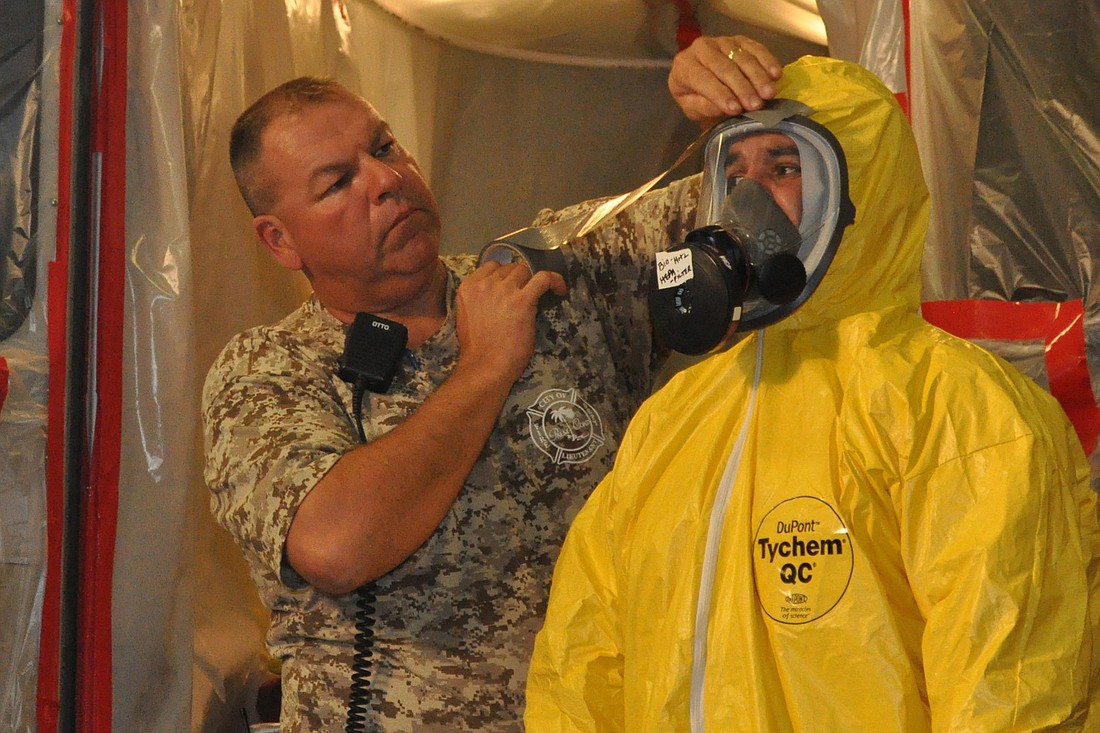- February 25, 2025

It looks like a normal ambulance from the outside. But not once the rear doors are opened: The entire interior of the ambulance’s patient transport area is coated in plastic sheeting and red tape, sealed tight to keep anything biologically dangerous — Ebola virus, or any other serious infectious disease — inside.
“We have taken a spare rescue unit that we had available at our warehouse, at our vehicle storage building, and we have outfitted this particular unit that can respond 24 hours a day, seven days a week to any type of infectious disease situation,” Flagler County Emergency Management Director Kevin Guthrie said at a Nov. 13 press conference.
The county’s emergency management and fire departments have come together with Florida Hospital Flagler and local municipal police and fire departments to form an incident management team that can respond to infectious disease threats, Guthrie said — setting aside the spare ambulance, checking equipment, and brushing up on training. The formation of the team was spurred by concerns about Ebola, but it could be used to respond to other biohazards like Enterovirus D68, and the decontamination measures emergency responders have trained for have been used locally in the past for anthrax.
“There have been questions: ‘Are you prepared at the local level; are you prepared at the state level?’” Guthrie said. “I can’t speak to the state, I can’t speak to the CDC, but I can ensure our Flagler county residents that we are prepared.”
In a demonstration for reporters, two rescuers helped Palm Coast firefighter Joey Paci don a bright yellow protective suit, mask and multiple sets of gloves, sealing and open areas — between the mask and the rest of the suit, the suit and the gloves — with duct tape.
The suits are in fact chemical suits, made for chlorine and ammonia atmospheres, according to Flagler County Fire Rescue Training Chief Lenny Ensalaco, and actually “overprotect” the wearer from a biohazard like Ebola.
They are placed not only in the designated ambulance, but in every other rescue unit in the county, he said.
If the county were to get a call that required the special ambulance, four rescuers would suit up: two to get the patient, and two to relieve them, if needed.
Florida Hospital Flagler has also designated an area of the hospital to be used for a patient with such a disease, with separate bathrooms and areas for workers to put on and take off chemical suits, said Kristin McCabe-Cline, medical director for the Florida Hospital Flagler Emergency Department and for Flagler County, Palm Coast and Flagler Beach EMS services.
Local first responders have trained for such cases in the past, Guthrie said. In October, he said, Flagler County Emergency Management coordinate with Florida Hospital Flagler and the department of health, “and made a decision based on the Ebola situation that was going on, but more holistically, the infectious disease control measures that we have in place and have had in place for Flagler County for quite some time. We thought it was a good time to look at our coffers of equipment, to see what we have and get ready to do some refresher training.”
All of the first responders in the county, including fire rescue and law enforcement staff, had mandatory training the week of Nov. 3.